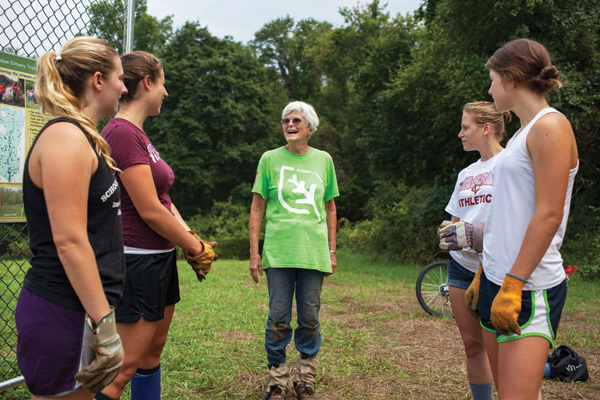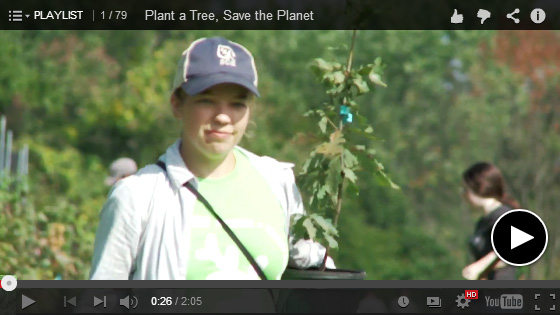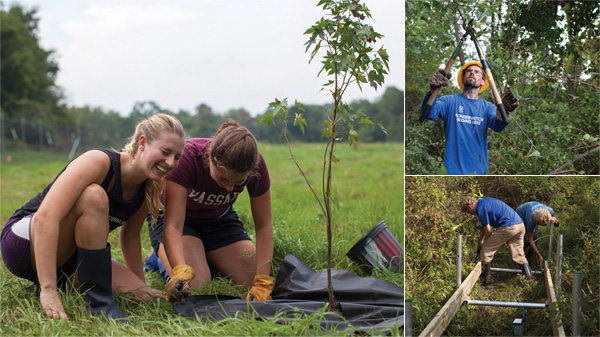Planting Trees Where Roots Are Buried
The heat and humidity had risen into the mid-80s well before noon, but the steamy weather wasn’t slowing Elizabeth Cushman Titus Putnam. Clad in jeans, a T-shirt and well-worn leather gloves, Putnam strode purposefully up a path at the Vassar Farm and Ecological Preserve on the morning of September 11 and pronounced herself ready for work.

“I’m here to plant some trees,” the 1955 Vassar grad told a group of young people from the national Student Conservation Association (SCA) who greeted her in a five-acre field. A few minutes later, Putnam was kneeling in the dirt, guiding a two-foot sapling into a hole that had been dug the day before.
Over the next three days, 40 SCA participants and more than 200 Vassar volunteers planted nearly 1,100 trees on the site to help curb erosion along two nearby streams. SCA workers also ripped down invasive Oriental bittersweet vines that were choking hundreds of trees on the 530-acre preserve, and they built boardwalks over some wetlands at two sites, one of which had been flooded last year by a dam built by a pair of beavers.
Liz Putnam didn’t have to introduce herself to the recent college graduates who were working for the SCA. They all knew she had founded the national organization in 1957, two years after she wrote her Vassar senior thesis proposing the idea. Since then, more than 70,000 young people have been doing one-year stints with the SCA (now affiliated with AmeriCorps), carrying out conservation projects throughout the country. But this one was special, Putnam said, because it was the first to be done on the Vassar campus. “This is where it all began, and I am just blown away by this project and all the people who helped bring it together,” she says.

The volunteers came from everywhere in the Vassar community. Most of the women’s field hockey and lacrosse teams showed up to help. So did the men’s and women’s rugby teams, as well as students from several science classes. Others decided to come out on their own after reading a campus-wide email from Dean of the College Christopher Roellke.
The young men and women in the Student Conservation Association who took part in the project say they were honored to have Putnam join them. SCA intern Daniel Molinaro, who oversaw one of the boardwalk projects, says, “Just seeing her enthusiasm gives you energy. It’s empowering to know [the SCA] got started because of what she did on this campus 58 years ago,” Molinaro says.
Putnam first conceived the idea for a youth conservation corps in 1953 when she read an article in Harper’s Magazine entitled, “Let’s Close the National Parks.” The gist of the article was that our parks were being “loved to death” because we had so few people taking care of them. She shared the article with her advisor, the late Professor A. Scott Warthin, Jr., who urged her to write her senior thesis in the spring of 1954 proposing the idea for a youth corps; he also suggested she pursue her proposal when she graduated.
Through a series of other Vassar connections, including the invaluable teamwork of Martha Hayne Talbot ’54, Putnam was able to pitch the idea to top officials in the National Park Service, and the first volunteers—53 high school, college, and graduate students—reported for duty two years later at Olympic and Grand Teton National Parks.
Putnam has remained active with the SCA ever since, and in 2010 President Obama presented her with the Presidential Citizens Medal—the second-highest civilian honor in the United States—for her lifelong environmental work.
Putnam also received AAVC’s 2010 Spirit of Vassar award for her work with the SCA, and she was reunited with one of the presenters of that award, President Catharine Bond Hill, when Hill stopped by to help with the tree-planting efforts the morning of September 13.

Hill assured Putnam, “I’ll be coming up here every once in a while to check on my trees.”
Keri VanCamp, manager of the preserve, says, “The direct and indirect effects the SCA has had on conservation in our country are immeasurable and make Liz Putnam one of the most important conservation leaders of our time. Her presence at this event made it feel like her idea for student engagement through the SCA had come full circle.”
Alistair Hall ’11, the college’s sustainability coordinator, says Vassar intends to use the three-day event as a model for future conservation projects on campus. “I loved that this effort brought the Vassar community together to experience the Vassar Farm and Ecological Preserve.”
Speaking to the SCA and Vassar volunteers at a farewell luncheon, Putnam urged them to use the event as a springboard for future endeavors.
“Wherever you go for the rest of your lives, remember this and do more good work,” she says. “Trust me, 58 years go by very fast, so whatever you can do to preserve the land, do it now. What you did here at Vassar was a real challenge and you were up for it. I am so grateful and honored to have been included.”
